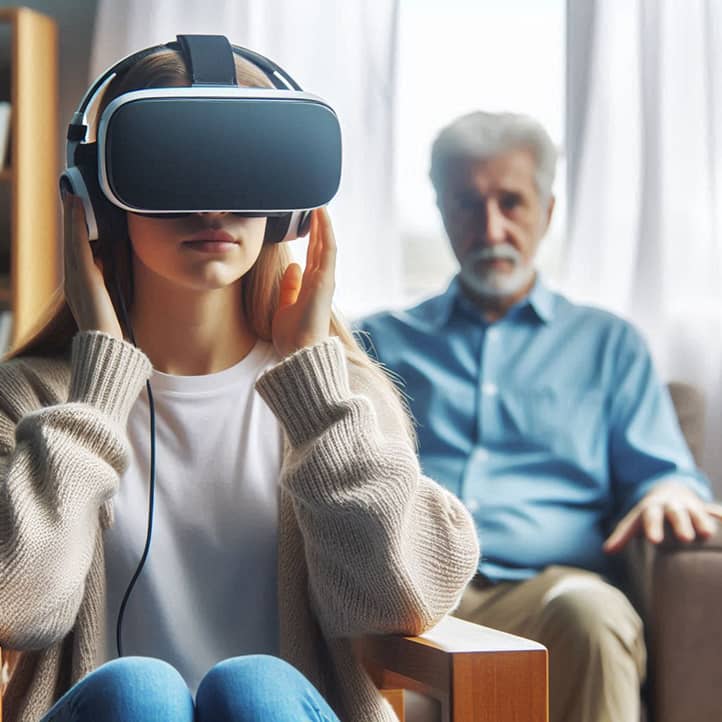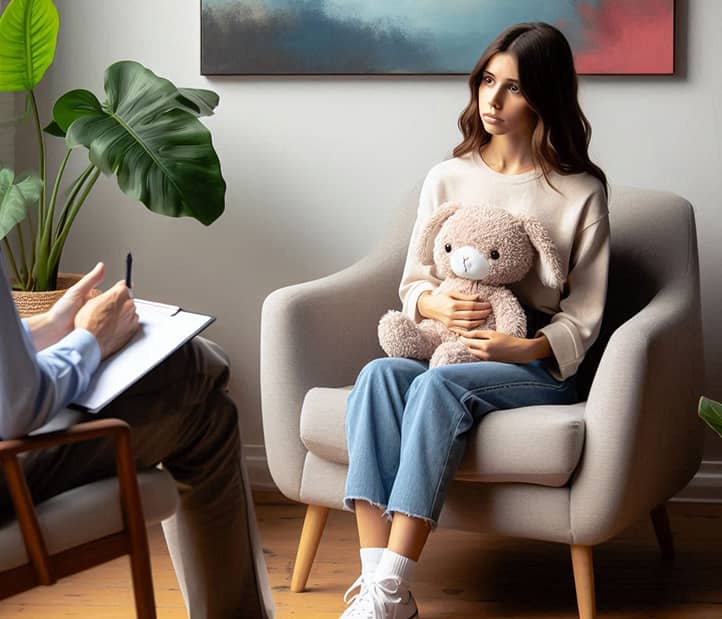Exposure therapy is one of the most effective methods for treating various anxiety disorders, phobias, and post-traumatic stress disorder (PTSD). This approach, based on the principles of cognitive-behavioral therapy, helps individuals overcome their fears through gradual and controlled exposure to objects or situations that trigger anxiety. In this article, I will provide a detailed explanation of what exposure therapy is, how it works, and when it is used.

What is Exposure Therapy?
Exposure therapy is a psychotherapeutic method in which a person deliberately confronts situations, objects, or memories that provoke fear or anxiety. The goal of this approach is to gradually reduce the intensity of the emotional reaction to the fearful stimulus, helping the patient learn to cope with their phobias more effectively.
The origins of exposure therapy can be traced back to the early 20th century, when psychologists began experimenting with methods to treat phobias by direct contact with frightening objects. However, a major breakthrough occurred in the 1950s when South African psychiatrist Joseph Wolpe developed the technique of systematic desensitization. This technique, a precursor to modern exposure therapy, combined gradual exposure with relaxation techniques.
In the 1960s and 1970s, psychologists such as Edna Foa and Michael Kozak continued to develop and refine exposure therapy methods. Their work led to the creation of more structured and effective treatment protocols, which are now widely used in clinical practice.

Theoretical Foundations
The human brain has an extraordinary ability to adapt. This plasticity underlies our capacity to learn, change, and overcome challenges. Exposure therapy leverages this fundamental feature of the nervous system to help people overcome deeply ingrained fears and anxieties.
Fear, in its essence, is a defense mechanism evolved to ensure our survival. However, in the modern world, this ancient system often malfunctions, creating false anxieties and irrational fears. Exposure therapy aims to recalibrate this system, restoring it to a more adaptive functioning.
The process of overcoming fear through exposure can be compared to physical training. Just as muscles strengthen under load, our psyche becomes more resilient when we regularly and in a controlled manner confront what scares us. This gradual building of psychological endurance is at the core of the long-term effectiveness of exposure therapy.
Cognitive-Behavioral Approach
Exposure therapy is closely linked to cognitive-behavioral therapy (CBT) – one of the most studied and effective approaches in psychotherapy. CBT is based on the idea that our thoughts, emotions, and behaviors are interconnected, and changing one of these components can lead to changes in others.
In the context of exposure therapy, the cognitive-behavioral approach suggests that avoidance of frightening situations or objects maintains and reinforces fear. Through gradual and controlled confrontation with these situations, a patient can:
- Change their negative beliefs and expectations about the feared stimulus.
- Learn more adaptive ways to respond to anxiety.
- Understand that avoidance is neither necessary nor helpful in the long term.
The Principle of Habituation
The key mechanism underlying the effectiveness of exposure therapy is the principle of habituation. Habituation is a natural process in which repeated exposure to a stimulus leads to a decrease in response to it.
In the context of exposure therapy, this means that:
- Upon initial confrontation with a feared object or situation, anxiety levels are usually high.
- If the person remains in the situation long enough, without resorting to avoidance or protective behaviors, anxiety levels begin to decrease naturally.
- With each subsequent exposure, the initial level of anxiety is typically lower, and the decrease happens more quickly.
This process allows the patient to gradually become accustomed to the fearful stimulus and learn that the situation is not as dangerous as initially thought.

Types of Exposure Therapy
The diversity of human experience is reflected in the variety of approaches to exposure therapy. Each method, like a tool in the hands of an experienced craftsman, is selected individually, taking into account the unique nature of the fears and personality characteristics of the patient.
The choice of a specific type of exposure often resembles a balancing act. On the one hand, it is necessary to create a realistic enough experience to activate the fear mechanisms. On the other – it is essential to ensure a level of control and safety, allowing the patient to avoid overexertion and successfully go through the therapy process.
Technological progress opens new horizons in exposure therapy. Virtual reality, for example, allows the creation of complex, multi-dimensional scenarios that would be impossible or too risky in the real world. This expands therapy possibilities, making it more accessible and effective for a wide range of patients.
Exposure therapy can be conducted in various ways, depending on the patient’s specific needs, type of disorder, and practical considerations. The main types of exposure therapy include:
In Vivo Exposure (Real-Life Exposure)
In vivo exposure is considered the gold standard in exposure therapy. In this approach, the patient confronts a real object or situation that causes fear, in controlled conditions under the therapist’s supervision.
Advantages of in vivo exposure:
- Most realistic experience.
- High effectiveness.
- Direct confrontation with fear in real life.
Disadvantages:
- May be too intense for some patients.
- Not always practical or safe (e.g., fear of flying).
Imaginal Exposure
In imaginal exposure, the patient mentally imagines the fearful situation or object in detail under the guidance of a therapist. This method is especially useful when direct confrontation with the object of fear is impossible or undesirable.
Advantages of imaginal exposure:
- Safe and controllable.
- Can be used for a wide range of fears and traumatic memories.
- Helps prepare for real-life exposure.
Disadvantages:
- May be less effective for some patients.
- Requires good imagination and visualization skills.
Virtual Reality in Exposure Therapy
The use of virtual reality (VR) in exposure therapy is a relatively new but rapidly developing approach. VR allows the creation of a realistic, three-dimensional environment where patients can safely confront their fears.
Advantages of VR exposure:
- High degree of control over stimuli.
- Ability to gradually increase the intensity of exposure.
- Safety and convenience for the patient.
Disadvantages:
- High cost of equipment.
- May cause side effects (e.g., dizziness) in some people.
- Limited range of available scenarios.
Each of these methods has its advantages and may be more or less appropriate depending on the specific case. Therapists often use a combination of different types of exposure to achieve the best results.

The Process of Exposure Therapy
Going through exposure therapy can be likened to climbing a mountain. Each step brings you closer to the summit – freedom from obsessive fears – but requires effort, courage, and perseverance. The therapist’s role in this journey is similar to that of an experienced mountain guide, who knows the safe paths and can support you in difficult moments.
A key element of success in exposure therapy is an individualized approach. Each patient arrives with a unique set of fears, experiences, and resources. Therefore, the psychotherapy process, while following general principles, is always adapted to the specific person, taking into account their pace, readiness, and reactions.
One of the most challenging but essential aspects of the process is teaching the patient the art of “staying” in discomfort. This ability to not run from fear, but to observe it, allowing it to be, gradually transforms the person’s attitude not only toward a specific phobia but also toward life’s difficulties in general.
Exposure therapy is a structured process that typically goes through several key stages. Understanding this process is important for both therapists and patients to ensure effective and safe treatment.
Assessment and Diagnosis
The first step in exposure therapy is a thorough assessment of the patient’s condition. At this stage, the therapist:
- Conducts a detailed interview to identify the specifics of the patient’s fears and anxieties.
- Uses standardized psychological tests and questionnaires to assess the severity of symptoms.
- Determines whether exposure therapy is an appropriate treatment method for the case.
- Rules out contraindications or comorbid disorders that may require additional attention.
This step is crucial as it allows the therapist to develop an individualized treatment plan that takes into account each patient’s unique needs and circumstances.
Creating a Fear Hierarchy
After the assessment is completed, the therapist and patient collaboratively create a fear hierarchy. This is a list of situations or objects that trigger anxiety, arranged in ascending order from the least to the most frightening. The process of creating a hierarchy includes:
- Identifying all situations that provoke fear or anxiety.
- Evaluating the level of discomfort each situation evokes in the patient (usually on a scale from 0 to 100).
- Ordering the situations in ascending order of anxiety level.
An example of a fear hierarchy for a person with social anxiety might look like this:
- Talking on the phone with a friend (20 out of 100).
- Ordering coffee in a café (40 out of 100).
- Having a small talk with a stranger (60 out of 100).
- Speaking in front of a small group of familiar people (80 out of 100).
- Public speaking in front of a large audience (100 out of 100).
This hierarchy serves as a roadmap for therapy, allowing one to start with less frightening situations and gradually progress to more challenging ones.
Gradual Exposure
The main part of exposure therapy involves the gradual and systematic exposure of the patient to the feared stimuli. This process typically includes the following steps:
- Starting with the least frightening situation from the fear hierarchy.
- Staying in the situation long enough for the anxiety level to naturally decrease (usually 30-60 minutes or longer).
- Repeating exposure to this situation until it causes minimal discomfort.
- Moving on to the next, more challenging situation in the hierarchy.
It is important to note that the pace of progression through the hierarchy is individual and depends on the patient’s readiness and progress. Some people may require several sessions at one level before they are ready to move on.
The Role of the Therapist in the Process
The therapist plays a critically important role in exposure therapy. Their tasks include:
- Providing a safe and supportive environment for the patient.
- Offering clear instructions and explanations at each stage of therapy.
- Monitoring the patient’s anxiety levels and reactions during exposure.
- Preventing the patient from using safety behaviors that may hinder the habituation process.
- Teaching the patient techniques for managing anxiety and stress.
- Encouraging and supporting the patient during difficult moments.
The therapist also helps the patient analyze the experience of each exposure, identifying and correcting unrealistic expectations or negative thoughts that may maintain anxiety.
The process of exposure therapy requires time and effort from both the patient and the therapist. However, when conducted correctly, it can lead to significant and long-term reduction in symptoms of anxiety and fear, improving the patient’s quality of life.

Applications
Exposure therapy demonstrates remarkable versatility in the treatment of various mental disorders. Its effectiveness in such a wide range of conditions highlights the fundamental role of habituation and learning mechanisms in the human psyche.
It is interesting to note that the application of exposure therapy is not limited to clinical cases. Its principles are reflected in various life domains, from sports, where athletes gradually increase loads, to public speaking, where speakers hone their skills through regular practice in front of an audience.
The expansion of exposure therapy applications continues today. Researchers are exploring its use in treating chronic pain, eating disorders, and even in managing stress in daily life, indicating the potential for the method to extend beyond traditional psychotherapy.
Exposure therapy has proven effective in treating a wide range of psychological disorders related to anxiety and fear. Here are the main areas of its application:
Phobias (specific phobias, social phobia)
Specific phobias are an intense, irrational fear of a particular object or situation. Exposure therapy is especially effective in treating phobias such as:
- Acrophobia (fear of heights)
- Aviophobia (fear of flying)
- Arachnophobia (fear of spiders)
- Claustrophobia (fear of enclosed spaces)
In treating specific phobias, the patient is gradually exposed to the feared object, starting with the least frightening situations and slowly progressing to more challenging ones.
Social phobia, or social anxiety disorder, is characterized by an intense fear of social situations. Exposure therapy helps patients gradually get used to social interactions, beginning with less stressful situations (such as a short conversation with one person) and progressing to more complex ones (such as speaking before a group).
Panic Disorder
In panic disorder, exposure therapy often includes:
- Interoceptive exposure: Patients intentionally trigger physical sensations associated with panic (e.g., rapid heartbeat through exercise) to learn not to fear these sensations.
- Situational exposure: Gradual confrontation with situations that typically trigger panic attacks (such as riding the subway or being in crowded places).
The goal of therapy is to help the patient understand that the physical sensations associated with anxiety are not dangerous and learn to cope with them without avoiding frightening situations.
Post-Traumatic Stress Disorder (PTSD)
In PTSD, exposure therapy helps patients cope with memories of a traumatic event and associated triggers. This may include:
- Imaginal exposure: The patient repeatedly recounts the traumatic event in detail, helping to reduce the emotional intensity of the memories.
- In vivo exposure: Gradual confrontation with safe situations that remind them of the trauma (for example, for a veteran, this could involve visiting crowded places).
It is important to note that exposure therapy for PTSD should be conducted by an experienced professional to minimize the risk of retraumatization.
Obsessive-Compulsive Disorder (OCD)
In OCD, exposure therapy is usually combined with ritual prevention. This approach, known as exposure and response prevention (ERP), includes:
- Gradual exposure to situations or objects that trigger obsessive thoughts.
- Consciously refraining from performing compulsive rituals.
For example, a person with obsessive thoughts about cleanliness might start by touching slightly “dirty” objects and gradually move to more challenging situations, without performing the ritual of washing their hands.

Method Effectiveness
The scientific community is highly interested in studying the mechanisms underlying the effectiveness of exposure therapy. Modern research in neurobiology sheds light on how regular exposure to fear changes the activity of various brain structures, particularly the amygdala and prefrontal cortex.
One intriguing aspect of exposure therapy is its ability not only to reduce the symptoms of a specific disorder but also to improve patients’ overall quality of life. Studies show that successfully overcoming fears often leads to increased self-esteem, improved social relationships, and even positive changes in the professional sphere.
It is important to note that the effectiveness of exposure therapy is not limited to short-term results. Long-term studies demonstrate the sustainability of achieved improvements, which is especially valuable in the context of chronic disorders. This suggests that the method does not simply “mask” symptoms but fosters deep psychological changes.
Research and Statistics
Exposure therapy is one of the most extensively studied and proven-effective treatments for anxiety disorders. Numerous studies confirm its effectiveness:
- A meta-analysis published in the Clinical Psychology Review in 2018 showed that exposure therapy significantly outperforms placebo effects in treating anxiety disorders.
- A 2019 study published in the Journal of Anxiety Disorders indicated that approximately 60-70% of patients with various phobias achieve clinically significant improvement after a course of exposure therapy.
- For PTSD, a 2013 meta-analysis published in the Clinical Psychology Review demonstrated that exposure therapy leads to significant reductions in PTSD, depression, and anxiety symptoms, with sustained effects in long-term follow-ups.
Comparison with Other Treatment Methods
When compared with other treatment methods for anxiety disorders, exposure therapy often shows comparable or superior effectiveness:
- Compared to pharmacotherapy: While medication treatment can be effective for quick symptom relief, exposure therapy often shows more long-term results and a lower risk of relapse after treatment cessation.
- Compared to other forms of psychotherapy: Exposure therapy often shows comparable or better effectiveness, especially for specific phobias and PTSD.
- Combined treatment: In some cases, particularly in severe forms of disorders, a combination of exposure therapy with medication treatment is the most effective strategy.
It is important to note that the effectiveness of any treatment method may vary depending on the patient’s individual characteristics and the specifics of the disorder.

Advantages and Disadvantages
Exposure therapy is often compared to the vaccination process in a psychological context. Just as a vaccine introduces the immune system to a weakened pathogen, exposure allows the psyche to “meet” fear in controlled conditions, developing resilience to it.
One of the most intriguing aspects of exposure therapy is its potential for developing psychological flexibility. Patients not only overcome specific fears but also learn new ways of interacting with discomfort and uncertainty, which can be beneficial in various life situations.
It’s important to understand that the effectiveness of exposure therapy largely depends on the patient’s readiness for change. This method requires active participation and a certain amount of courage, which can be challenging for some individuals. However, it is this active role of the patient in the treatment process that often becomes the key to long-term success.
Pros of Exposure Therapy
- Long-term effectiveness: The effects of exposure therapy often persist long after treatment ends.
- Lack of side effects associated with medication.
- Development of coping skills: Patients learn to actively confront their fears, which can be beneficial in various life situations.
- Increased self-efficacy: Successfully overcoming fears can significantly boost the patient’s confidence.
- Relatively short treatment duration: Many patients achieve significant improvement within 8-12 sessions.
Potential Risks and Limitations
- Temporary increase in anxiety: At the beginning of treatment, patients may experience a heightened level of discomfort.
- Risk of dropout: Due to the intensity of the therapy, some patients may prematurely discontinue treatment.
- Limited applicability: Not all patients are suitable candidates for exposure therapy, especially those suffering from multiple or complex mental disorders.
- Need for an experienced therapist: The effectiveness of the therapy largely depends on the therapist’s qualifications and experience.
- Ethical considerations: Some forms of exposure may raise ethical questions, particularly when dealing with traumatic memories.

Combination with Other Methods
Integrating exposure therapy with other treatment methods opens new horizons in psychotherapy. Similar to how combining ingredients in cooking creates a unique flavor, combining therapeutic approaches can achieve a more profound and comprehensive effect.
A particularly interesting area is the interaction of exposure therapy with modern advances in neuroscience. For example, the use of neuroimaging allows for a better understanding of how exposure affects the activity of different areas of the brain, which in turn helps optimize the treatment process.
In the context of personalized medicine, combining methods is especially significant. A personalized approach that takes into account genetic, neurobiological, and psychosocial factors allows for the creation of unique therapeutic “cocktails” that are maximally effective for each individual patient.
Combination with Medication
In some cases, exposure therapy becomes more effective when combined with pharmacotherapy:
- Antidepressants (SSRIs): These can help reduce overall anxiety levels, easing the exposure process.
- Anxiolytics: These are sometimes used short-term to alleviate intense anxiety at the beginning of treatment, though their long-term use is generally not recommended.
- D-cycloserine: Some studies suggest that this medication can enhance the effects of exposure therapy by accelerating the habituation process.
It is important to note that the decision to combine medication with exposure therapy should be made on an individual basis for each patient.
Integration with Other Psychotherapeutic Approaches
Exposure therapy is often integrated with other psychotherapy methods to enhance treatment effectiveness:
- Cognitive therapy: Helps patients identify and modify irrational thoughts related to their fears.
- Mindfulness techniques: Assist patients in better managing anxiety during exposure.
- Dialectical behavior therapy (DBT): DBT elements can be beneficial for patients with difficulties in emotion regulation.
- Acceptance-oriented approaches: Help patients accept the presence of anxiety and learn to live a full life despite it.
Integrating different approaches allows for a more comprehensive and individualized treatment program, taking into account the unique needs of each patient.

Conclusion
Exposure therapy is a powerful tool in modern psychotherapy, effectively addressing a wide range of anxiety disorders. Based on fundamental principles of psychology and neurobiology, it helps patients not only overcome their fears but also gain new insights into themselves and their capabilities.
The success of exposure therapy is largely due to its adaptability to each patient’s individual needs. From classic in vivo exposure methods to innovative approaches using virtual reality, this method continues to evolve, opening up new possibilities for treating an ever-wider range of psychological issues.
Despite its proven effectiveness, exposure therapy continues to develop and improve. Integrating with other therapeutic approaches, using the latest technologies, and deepening our understanding of the mechanisms of fear and anxiety offer promising prospects for even more effective and personalized treatment. In the future, we can expect further expansion of the method’s applications, allowing it to help even more people overcome their fears and break free from limitations.




